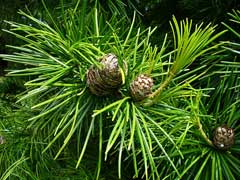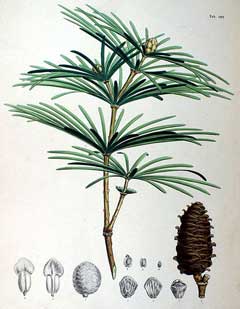 |
|
www.flickr.com/photos/scottzona |
 |
| http://commons.wikimedia.org/wiki/File:Sciadopitys_verticillata_SZ102.jpg |
Translate this page:
Summary
Form: Pyramidal.
Physical Characteristics

 Sciadopitys verticillata is an evergreen Tree growing to 15 m (49ft) by 6 m (19ft) at a medium rate.
Sciadopitys verticillata is an evergreen Tree growing to 15 m (49ft) by 6 m (19ft) at a medium rate.
See above for USDA hardiness. It is hardy to UK zone 6. It is in leaf all year, in flower in May, and the seeds ripen from October to November. The species is monoecious (individual flowers are either male or female, but both sexes can be found on the same plant) and is pollinated by Wind.
Suitable for: light (sandy), medium (loamy) and heavy (clay) soils. Suitable pH: mildly acid, neutral and basic (mildly alkaline) soils and can grow in very acid soils.
It can grow in semi-shade (light woodland) or no shade. It prefers moist or wet soil.
UK Hardiness Map
US Hardiness Map
Synonyms
Plant Habitats
Woodland Garden Canopy; Bog Garden;
Edible Uses
Edible Parts: Oil
Edible Uses: Oil
None known
References More on Edible Uses
Medicinal Uses
Plants For A Future can not take any responsibility for any adverse effects from the use of plants. Always seek advice from a professional before using a plant medicinally.
None known
References More on Medicinal Uses
The Bookshop: Edible Plant Books
Our Latest books on Perennial Plants For Food Forests and Permaculture Gardens in paperback or digital formats.

Edible Tropical Plants
Food Forest Plants for Hotter Conditions: 250+ Plants For Tropical Food Forests & Permaculture Gardens.
More

Edible Temperate Plants
Plants for Your Food Forest: 500 Plants for Temperate Food Forests & Permaculture Gardens.
More

More Books
PFAF have eight books available in paperback and digital formats. Browse the shop for more information.
Shop Now
Other Uses
Dye Oil Varnish Wood
An oil obtained from the wood is used for varnishes and dyes[61]. Wood - soft, elastic, water-resistant. Used for boats etc[46, 61].
Special Uses
References More on Other Uses
Cultivation details
Landscape Uses:Border, Container, Pest tolerant, Screen, Specimen. Prefers a good loamy soil[11]. Grows well near water, tolerating a wet site[81]. Thrives in all conditions except limey soils[81]. It prefers a pH in the range of 4 to 6, and although it will grow at pH 7 or above it becomes chlorotic[200]. Tolerates some shade but prefers an open position in full sun[81]. Dislikes cold or violent winds[1]. Grows best in mild damp areas with warm humid summers[200]. A very hardy plant[11], tolerating temperatures down to about -30°c when it is fully dormant[200]. A slow-growing tree when very young[11, 81]. Some trees have grown slowly but generally they are of moderate growth in Britain, often averaging 30cm a year and increasing their girth by 2.5cm a year[185]. The cones ripen over a period of 2 years[188]. There are two forms of this species, one is shrub-like whilst the other is a tall-growing tree[11]. Plants should be put into their permanent positions as soon as possible in order for them to develop a good root system, plants more than 1 metre tall check badly for a number of years[200]. This species is notably resistant to honey fungus[200]. Special Features:
Attractive foliage, Not North American native, Inconspicuous flowers or blooms.
References Carbon Farming Information and Carbon Sequestration Information
Temperature Converter
Type a value in the Celsius field to convert the value to Fahrenheit:
Fahrenheit:
The PFAF Bookshop
Plants For A Future have a number of books available in paperback and digital form. Book titles include Edible Plants, Edible Perennials, Edible Trees,Edible Shrubs, Woodland Gardening, and Temperate Food Forest Plants. Our new book is Food Forest Plants For Hotter Conditions (Tropical and Sub-Tropical).
Shop Now
Plant Propagation
Seed - requires 3 months cold stratification and so it can be sown in a cold frame either as soon as it is ripe in the autumn or in January[113]. Only cover the seed lightly and place the pot in a sunny position[113]. The seed can be difficult to germinate[81]. Prick out the seedlings into individual pots as soon as they are large enough to handle and grow them on in the cold frame for their first winter. Plant them out in late spring or early summer of the following year. The seedlings are very slow-growing and take about 3 years to reach 30cm tall[113] so be sure to mulch them well and perhaps give them some protection such as a tree guard made from a plastic bottle with its top and bottom removed[K].
Other Names
If available other names are mentioned here
Native Range
TEMPERATE ASIA: Japan (Honshu, Kyushu (east), Shikoku)
Weed Potential
Right plant wrong place. We are currently updating this section.
Please note that a plant may be invasive in one area but may not in your area so it's worth checking.
Conservation Status
IUCN Red List of Threatened Plants Status :

Growth: S = slow M = medium F = fast. Soil: L = light (sandy) M = medium H = heavy (clay). pH: A = acid N = neutral B = basic (alkaline). Shade: F = full shade S = semi-shade N = no shade. Moisture: D = dry M = Moist We = wet Wa = water.
Now available:
Food Forest Plants for Mediterranean Conditions
350+ Perennial Plants For Mediterranean and Drier Food Forests and Permaculture Gardens.
[Paperback and eBook]
This is the third in Plants For A Future's series of plant guides for food forests tailored to
specific climate zones. Following volumes on temperate and tropical ecosystems, this book focuses
on species suited to Mediterranean conditions—regions with hot, dry summers and cool, wet winters,
often facing the added challenge of climate change.
Read More
Expert comment
Author
(Thunb.)Siebold.&Zucc.
Botanical References
1158200
Links / References
For a list of references used on this page please go here
Readers comment
© 2010, Plants For A Future. Plants For A Future is a charitable company limited by guarantee, registered in England and Wales. Charity No. 1057719, Company No. 3204567.